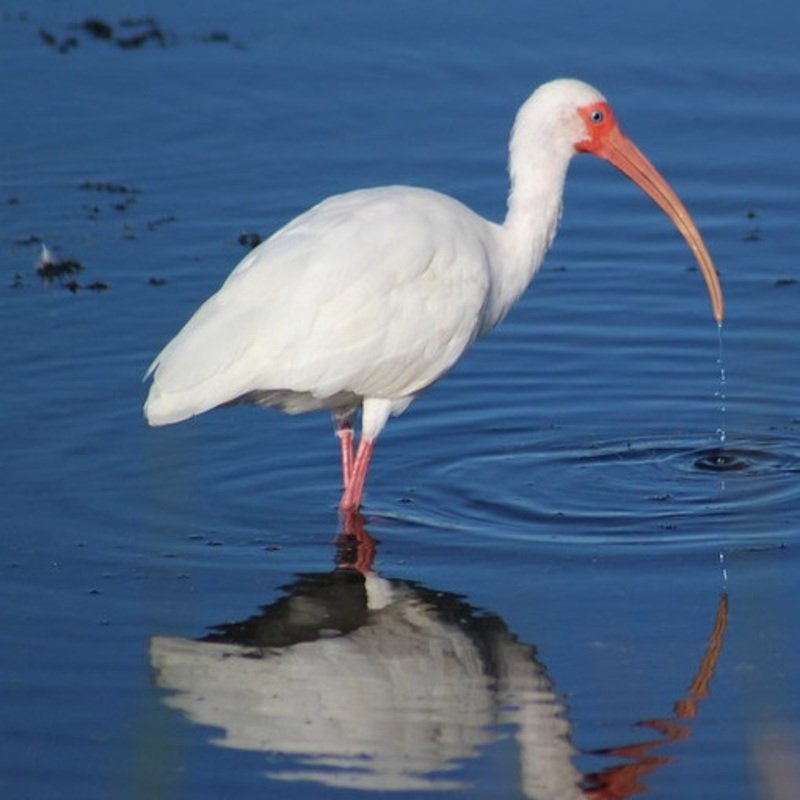The American white ibis, Eudocimus albus, is a Threskiornithidae bird species. It is distributed from Virginia down the US Gulf Coast to much of the New World tropics. This ibis is a medium-sized bird with a brilliant red-orange down-curved beak, long legs, and black wing tips visible only in flight. Males are bigger and have longer bills. The breeding range includes the Gulf, Atlantic, and Central American coastlines. During the mating season, the range expands into Canada and the Caribbean. It is found in Colombia and Venezuela on the northwestern South American coast. Central Venezuelan populations interbreed with the scarlet ibis.
Quick Overview: Eudocimus Albus – White Ibis
Body size: Around 21-27 in (53-69 cm) and a weight of 1043 g (36.
Main colors: White, Gray, Pink-White
Range: Eastern United States
Migratory Bird: Yes
Best time of the year to see in the U.S.: All Year (January – December)
Conservation Status: Least Concern
White Ibis Description
They are long-legged wading birds with white wings. Their large curved beak helps them eat. Females have shorter bills and wingspans than males. Adolescent white ibises have no feathers for 4–5 days. The feathers are dark gray and will not become white until adulthood. Juvenile white ibises have a pinkish-white, straight beak. Soon after the first two weeks, the bill begins to lengthen, bend downward, and resemble an adult bill. A white ibis’ sexually monomorphic alterations occur during the breeding season.

Size
These birds have a length of 21-27 in (53-69 cm) and a weight of 1043 g (36.8 oz). Their wings could range 21-27 in (53-69 cm)
Feeding
Because they eat in shallow water, many white ibises live in coastal or inland wetlands. White ibises spend the summer and winter along the shore, moving interior for the breeding and nesting seasons. White ibises may relocate owing to changes in water depth, which affects their eating and breeding habits.
Habitat
White ibises are colonists. These birds live in huge colonies of 500 to 15,000 birds. Large colonies help protect them from predators. If a predator threatens the colony, large numbers of ibises will gather together to help. The colony feeds, forages, nests, mats, and roosts together.
Behavior
White ibises are colonists. These birds live in huge colonies of 500 to 15,000 birds. Large colonies help protect them from predators. If a predator threatens the colony, large numbers of ibises will gather together to help. The colony feeds, forages, nests, mats, and roosts together.
Eudocimus Albus Scientific Classification
- Kingdom: Animalia
- Phylum: Chordata
- Subphylum: Chelicerata
- Class: Aves
- Order: Palecaniformes
- Family: Threskiornithidae
- Genus: Eudocimus
- Species: Eudocimus albus
Best time of the year to see
In the United States, the best time of year to see these birds is all year round, regardless of the season. This refers to any month of the year between January and December.
Distribution of the White Ibis in the USA
It ranges from Virginia to the New World tropics. The Gulf, Atlantic, and Central American coasts are breeding grounds. A mate’s range extends into Canada and the Caribbean. In Colombia and Venezuela on the northwestern coast of South America. Scarlet ibis interbreed in Venezuela. Experts say they are one species.
The White Ibis can be found in the following states in the United States – Alabama, Florida, Georgia, Louisiana, North Carolina, South Carolina, and West Virginia.

